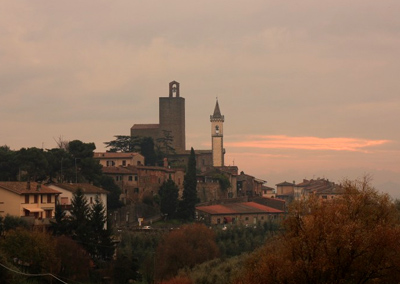
Better known as the birthplace of Leonardo da Vinci, romantic Vinci holds the same magic as the rest of Tuscany. It takes just half an hour’s drive from Florence through the scenic SS 67 route towards Empoli that takes you right to Vinci. Visitors to Vinci would appreciate the town better if they park on the outskirts and explore this medieval village by foot. As one nears the town, a big wooden sculpture of the Vitruvian man welcomes you. The square overlooks the valley below and is steep with a fabulous panoramic view. Vinci’s mysterious origins date back to the Etruscans.
Spectacular as the town where the famous Leonardo da Vinci was born, the small hill town of Vinci has not changed much for the past 544 years. Picturesque stone houses still cling to the strong battlements of the castle. Built in the Middle Ages, the castle came under the rule of the Florentines in 1254. Located on the hilltop, the castle stood witness as many a battle raged between Florence and Pisa. But the enchantment and peace of Vinci is still retained and enjoyed by the 14,000 people living there today. The borough of Vinci is situated in the heart of Tuscany a few kilometres from Florence, close to Pisa, and an hour’s drive from Lucca and Siena.
As an important landmark in Vinci, the tall church bell tower can still be seen for miles. Surrounded by fertile farmland, the hillsides around Vince are lush with vineyards and olive groves that grow around in the lovely landscapes. Leonardo da Vinci’s presence can be felt everywhere adding to the mysterious charm of Vinci. The slopes that are seen above Vinci rise to the Mount Albano where Leonardo da Vinci loved to walk. Scenic and beautiful, silvery streaks of small mountain streams run down from the mountain past Vinci to the valley of the Arno River below. Inspired by what he saw around him, Leonardo’s enchanted childhood led him to explore and study the woods, natural life and streams of Vinci which he depicted in his sketches. Later as he grew, Leonardo reflected these scenes in his detailed life-like paintings of plants and wildflowers at the feet of the angel in The Annunciation and the rocky caves and pools of water surrounding the figures in The Virgin of the Rocks.
Another feature that has endeared Vinci as an immortal town is its curious castle that is known as “The Ship’s Castle” because of its unusual shape. This castle houses the fascinating Il Museo Leonardiano Di Vinci. Displaying Leonardo’s mechanical, scientific and engineering inventions, the museum showcases Leonardo’s work through models constructed according to the original dimensions. The museum evolves over two floors and has computers which enable the visitors to view video presentations, play interactive games and acquire more information. The important feature of the models is that it displays the transition of Leonardo’s sketches into reality that cover a range of domed buildings, cars and planes to underwater suits. There is also a library that has a complete collection of his observations and ideas.
The castle opens its ancient path to view the lovely medieval town of Vinci. Quite close to the museum, the church of Santa Croce echoes with the whisper of legends that the great Leonardo da Vinci was baptized in its hallowed premises. Though this lovely little church has been renovated several times it still retains its medieval charm. Vinci’s winding streets, alleyways and stairways are fascinating with a wonderful discovery round every corner. Vinci’s repertoire of restaurants and shops are not wide and varied but small and wonderful. Vinci’s cuisine and crafts are a delight to experience as well as its great extra virgin olive oil and the Chianti Putto Montalbano, the local wine of Vinci.
Just a few kilometers away, the main town of Anciamo stands where Leonardo was born. Timeless and unique, Vinci opens paths to visit and be inspired by the town of Montelupo Fiorenti that is close by and famous for its ceramic. The Frescobaldi Tower houses the Glass Museum in Montelupo. The ceramic studio of the famous artisan, Fratelli Taccini can be found in Sovigliana di Vinci that displays the talented heritage of the Taccini family. The ‘Il Cristo Croce Fisso’ was made of clay and wrought iron in 1995 by Taccini. Vinci holds the essence of romance and fascination that has brought countless visitors to its lovely village to linger and absorb the magic of mystery.
Some links:
www.museoleonardiano.it
www.vinciturismo.it
www.prolocovinci.com
